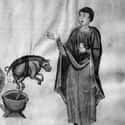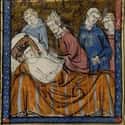-
(#3) St. Anthony's Fire
St. Anthony's Fire, caused by eating grains contaminated with the Claviceps purpurea fungus, is also known as ergotism. The ergot fungus grows on moldy grains and, once ingested, can cause redness, swelling, and gangrene. Rye was produced and consumed in large quantities by the poor and was especially susceptible to the ergot fungus, so the disease affected the lower classes in the greatest numbers.
When one is first struck with St. Anthony's Fire, red spots appeared on the flesh. The initial burning soon becomes excruciating as limbs swell; people often hallucinate, with some in the past believing they were in a fight with the devil. Sometimes, people have convulsions, but as their extremities begin to rot, toes, fingers, ears, and even arms or legs can fall off. Based on an account of the St. Antony's Fire outbreak that struck southern France during the 10th century:
The afflicted thronged to the churches and invoked the saints. The cries of those in pain and the shedding of burned-up limbs alike excited pity; the stench of rotten flesh was unbearable.
In 944 CE, 40,000 people in France perished from St. Anthony's Fire, and monastic hospitals were built throughout Europe to treat victims.
-
(#1) Leprosy
- Disease or medical condition
Caused by the Mycobacterium leprae bacteria, leprosy is, arguably, as misunderstood today as it was during the Middle Ages. Now called Hansen's Disease, leprosy results in skin lesions and nerve damage that can impair a person's eyes and limbs. Leprosy develops slowly, and visible symptoms can take decades to manifest.
In medieval society, lepers were shunned and cast out of cities, towns, villages, and even the smallest of communities. Leper hospitals were established outside of town centers during the 12th century in France and the Low Countries. Facilities tasked to solely care for lepers were known as leprosaria (or leprosariums) and fell under the charitable auspices of the Church.
Leprosy was common in both the Byzantine Empire and Western Europe from the 12th century forward, often transferred by pilgrims and Crusaders. Lepers were refused burial alongside non-lepers thanks to the Old Testament passage Leviticus 13:44-46:
He is leprous, he is unclean. The priest shall pronounce him unclean; the disease is on his head. The person who has the leprous disease shall wear torn clothes and let the hair of his head be disheveled; and he shall cover his upper lip and cry out, “Unclean, unclean.” He shall remain unclean as long as he has the disease; he is unclean. He shall live alone; his dwelling shall be outside the camp.
The social class of the leper dictated their overall reception, however. Alice the Leper, a lay sister from the Cistercian monastic order, remains the patron saint of the blind and the paralyzed after becoming both due to her leprosy.
-
(#5) Tuberculosis
- Disease or medical condition
Called the "white plague," "consumption," or "king's evil" during the Middle Ages, symptoms of tuberculosis include a fever and persistent coughing that can result in expressing white phlegm or blood. When the lymph nodes in one's neck become enlarged, the disease is also called scrofula.
Tuberculosis was believed to be contagious, but there were assertions that royalty could cure the disease with a simple touch. As early as the 11th century, King Edward the Confessor in England and Philip I in France conducted ceremonies to touch individuals suffering from scrofula. Those afflicted and touched received "touchpieces," or gold coin amulets, signifying the event.
Tuberculosis mostly afflicted poor town dwellers living in less than hygienic conditions.
-
(#4) Sweating Sickness
Largely associated with England, "sweating sickness" appeared several times from 1485 to the late 16th century. In 1485 alone, sweating sickness took the lives of 15,000 people in London. After the initial onslaught of the disease, it faded until 1508 and reappeared again in 1517. The sweating sickness jumped to Continental Europe and struck Flanders, Germany, Sweden, and several other locations during the 1520s before it reemerged in England for the last time in 1551.
The initial symptoms of the sweating sickness were "a sense of apprehension" followed by headaches, pain in one's back and shoulders, and nausea. This was followed by excessive sweating, delirium, and abdominal pain. The more severe symptoms lasted anywhere from 15 to 21 hours and accompanied extreme fatigue which could result in a coma or loss of life.
The sweating sickness mostly affected the upper class and could end the life of an adult in a matter of hours. During the outbreak of 1529, King Henry VIII so feared getting the disease that he "left in great haste, and went a dozen miles off" to hide from the affliction.
Researchers have theorized that the sweating sickness was caused by typhus, influenza, botulism, or the hantavirus, but no definitive source of the disease has been found.
-
(#8) Syphilis
- Disease or medical condition
The origins of syphilis remain contested, but by the late 15th century, the disease had hit Europe. In 1495, French soldiers were said to have contracted the disease during the siege of Naples, where it may have been widespread since as early as 1429. Spanish physician and scholar Gaspar Torella wrote about syphilis in the 1490s, describing the ulcers and swelling that could afflict one's genitals before other pains, pustules, and maladies appeared. He dedicated the work to Cesare Borgia (1475-1507), a Valencian military leader and statesman, because it was Borgia's affliction that brought the disease to light for the doctor.
Borgia may have contracted syphilis from a sex worker he visited in 1497. There are theories that Borgia perished of the disease, and he certainly demonstrated physical symptoms, described by a contemporary in 1504 as having a face that "was ravaged and blotched."
-
(#9) Pneumonia
Both pneumonia and pleurisy were common during the Middle Ages, and once the writings of Galen were translated into Latin during the 5th century, distinguishing between the two conditions became more clear. According to Galen's Therapeutics to Glaucon, both pneumonia and pleurisy were respiratory diseases, but the former presented with a fever, difficulty breathing, and chest pain.
Some individuals showed signs of redness and had difficulty laying down, often attributed to "humor in the lungs." In contrast, pleurisy also included chest pain, but the discomfort could radiate through the shoulders and down into one's groin. Both afflictions could result in coughing up blood. The important distinction was that pneumonia could lead to pleurisy, but the latter could also result from traumatic damage as well. Treatments for both were determined based on the cause.
Galen's contributions to understanding pneumonia were taken up by 12th-century philosopher and writer Moses Maimonides. He described the symptoms of pneumonia as "acute fever, sticking [pleruitic] pain in the side, short rapid breaths, serrated pulse and cough, mostly associated with sputum."
Being able to identify pneumonia made the plague outbreak of the 14th century more complicated, however. When individuals exhibited the symptoms associated with pneumonia, it was assumed they had the more dangerous of the two diseases. According to historian Ole Jorgen Benedictow, plague patients often coughed up blood regardless of what type of plague they had, making it difficult to assess how many cases of pneumonic plague truly presented themselves during the 14th century.
New Random Displays Display All By Ranking
About This Tool
The Middle Ages was called the Dark Age for no reason. People at that time were indeed living in fear, especially the poor, who faced constant religious wars and deadly infectious diseases. In the mid-fourteenth century, a plague swept across Europe, killing tens of millions of people, and reducing the population of Europe by one-third. That plague was also called the Black Death.
Many infectious diseases had even regularly repeated outbreaks, common diseases were malaria, diphtheria, flu, smallpox, and leprosy in the Middle Ages, which caused more deaths than ever. The random tool lists 13 dangerous infectious diseases you might suffer in a Medieval city.
Our data comes from Ranker, If you want to participate in the ranking of items displayed on this page, please click here.
















